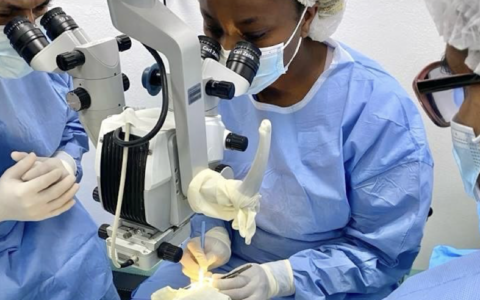Results of both three-year and eight-year analyses comparing outcomes of two different surgical treatment methods for childhood intermittent exotropia show no significant advantages to either technique.
Intermittent exotropia is typically treated with unilateral recession-resection (R&R) on the non-dominant eye or via bilateral lateral rectus muscle recession (BLRc) surgery. The fact that either surgery can be a valid option is especially important to experts like pediatric ophthalmologist and first author Sean Donahue, M.D., Ph.D., of Vanderbilt University Medical Center.
“People didn’t really know whether having surgery on the one muscle on each eye was any different than two muscles on the non-dominant eye. And that’s what this study was designed to answer,” Donahue said.
Although no consensus existed, previous data had suggested that patients who had the R&R approach had a somewhat more challenging and extended recovery time, Donahue explained. Therefore, BLRc was commonly chosen to minimize swelling and soreness post-treatment.
Urgency for Early Correction
Intermittent exotropia is a type of strabismus, commonly called “wandering eye,” that develops in childhood. It is characterized by an outward drift of the eye that occurs only some of the time. Intermittent exotropia manifests more frequently when the child is fatigued or has a systemic illness.
“Most of the people with constant exotropia got that way because they were intermittent and didn’t have surgical correction. Over time, it very slowly got worse.”
If untreated, intermittent exotropia can lead to constant exotropia, which is associated with a loss of depth perception as well as psychosocial problems. Because of this, most clinicians strongly encourage early surgical correction.
“Most of the people with constant exotropia got that way because they were intermittent and didn’t have surgical correction. Over time, it very slowly got worse,” said Donahue.
Two Surgical Options
Donahue and his colleagues within the Pediatric Eye Disease Investigator Group studied 197 children between the ages of 3 and 11 who had not undergone prior surgery for their intermittent exotropia. The children were randomized to one of the two procedures.
Because the participants were children, parental consideration was paramount. Researchers had to ensure that parents understood the surgery and the randomized distribution of surgeries, and that they were in full agreement with the treatment.
Equivocal Outcomes
To determine successful results after surgery, the researchers looked for an optimal surgical outcome using guidelines predetermined for exotropia, esotropia and stereoacuity loss, as well as reoperation necessity.
At the end of three years, suboptimal surgical outcomes were found in 46 percent of the BLRc group and 37 percent of the R&R group. Although slightly biased towards R&R, the researchers determined that there was no statistically significant evidence to determine superiority of one approach over the other.
“We found the outcomes were similar, whether you choose two muscles in the non-dominant eye or one muscle in each,” Donahue said.
Over the eight-year study extension period, results were proportionally similar, with 68 percent of those undergoing BLRc and 53 percent who had R&R having suboptimal outcomes. This difference was also not statistically significant.
However, a reoperation rate for the BLRc group that was at least twice as high as that for the R&R group has convinced Donahue to alter his surgical preferences for many of his intermittent exotropia patients.
“The reoperation rate was much higher when they did one muscle in each eye, so I’ve moved my practice pattern to either doing a larger amount of surgery when I do it on each eye or, alternatively, operating on two muscles in the non-dominant eye,” he said.
The study also showed that age played a role in surgical success, with younger children generally having better outcomes. Age also was the most influential factor impacting reoperation rates, which Donahue attributes in part to older patients likely having gone longer with their deviations prior to surgery.
“The older kids didn’t do as well as the younger kids in terms of reoperation rates,” Donahue said. “Overall, the surgeries proved to be quite safe for patients. There were no cases of vision loss, no cases of infection or bleeding in the eye, and no anesthetic complications, so the surgeries are actually very safe.”





